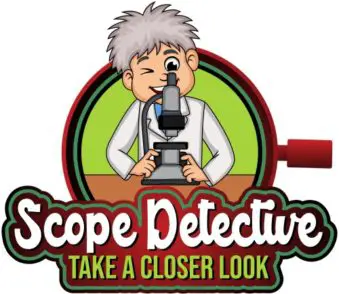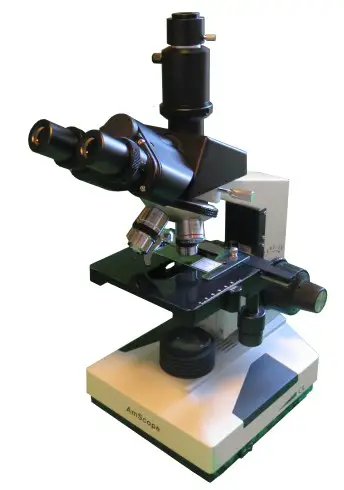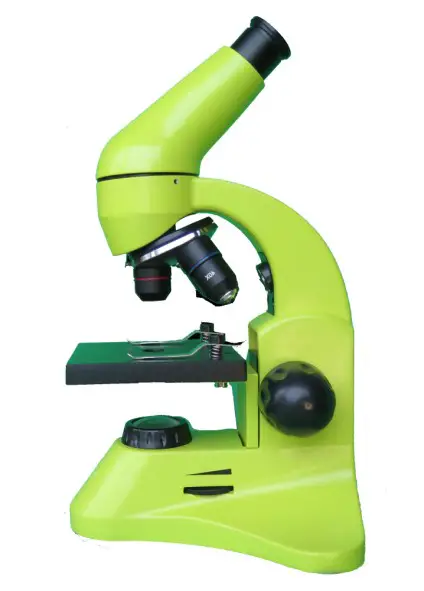 About this Article: Hi, I’m Chris – an amateur microscopist. This information is stated as personal opinion for my circumstances and does not constitute advice to you and your circumstances or guarantee quality or fit for purpose of the following products. Use of this website is governed by our Disclaimer, Terms and Conditions and Privacy Policy posted in the footer of this website. As an Amazon associate I earn from qualifying purchases. I may earn commissions from qualifying purchases from Amazon, Levenhuk and Amscope.
About this Article: Hi, I’m Chris – an amateur microscopist. This information is stated as personal opinion for my circumstances and does not constitute advice to you and your circumstances or guarantee quality or fit for purpose of the following products. Use of this website is governed by our Disclaimer, Terms and Conditions and Privacy Policy posted in the footer of this website. As an Amazon associate I earn from qualifying purchases. I may earn commissions from qualifying purchases from Amazon, Levenhuk and Amscope.I’ve reviewed 9 of the top compound microscopes below, but when it comes down to it, I’d recommend these as the top 2:
- Best for Adults, Hobbyists and Teachers – AmScope T490B
- Best Value for Money for Beginners & Casual Use – Levenhuk Rainbow 50L PLUS
I own both these microscopes and use them regularly. The photos of the T490B and 50L Plus in this article are of my own personal microscopes.
Compound microscopes are best for viewing things at a cellular level which are invisible to the naked eye such as cells and bacteria. If you’re wanting to view rocks or leaves, it might be better to go with a stereo microscope.
My Top Picks
BEST: The Amscope T490B is a best for people enthusiastic about filming their discoveries. This is the model for you if you want all the bells and whistles. With a mechanical stage, stage stop, trinocular lenses and high quality achromatic objectives, it suits hobbyists and professionals alike. I particularly like that I can film my projects through the third ocular lens (you’ll need a camera attachment – see here for a full guide on how to get started with photomicroscopy).
GOOD: The Levenhuk Rainbow 50L PLUS is an affordable entry-level compound microscope. It’s a model for people who want to mess around with basic compound microscope experiments like looking at onion skins or sea monkeys. In my opinion it’s the best quality of all the entry-level models.
Chart – Top Compound Microscopes (Ranked)
| # | Microscope | Type | Magnification Range | Camera* | Stage | Price |
| 1. | Amscope T490B – My Top Pick | Trinocular | 40x – 2000x | No | Mechanical | Check Here |
| 2. | Levenhuk Rainbow 50L Plus – Beginners Choice | Monocular | 64x – 1280x | No | Fixed | Check Here |
| 3. | Amscope B120B | Binocular | 40x – 2000x | No | Mechanical | Check Here |
| 4. | Swift SW380B | Binocular | 40x – 2500x | No | Mechanical | Check Here |
| 5. | Celestron CM2000CF | Monocular | 40x – 2000x | No | Mechanical | Check Here |
| 6. | OMAX MD82ES10 | Binocular | 40x – 2500x | 1.3MP | Mechanical | Check Here |
| 7. | Levenhuk 720B | Binocular | 40x – 2000x | No | Mechanical | Check Here |
| 8. | AmScope M150C-MS | Monocular | 40x – 1000x | No | Mechanical | Check Here |
| 9. | Telmu 40X – 1000X | Monocular | 40x – 1000x | No | Fixed | Check Here |
* I don’t recommend microscopes with cameras. Instead, I recommend buying a trinocular microscope then get a DSLR-to-microscope adapter for best quality images.
Which is the Best Compound Light Microscope?
1. Amscope T490B – Best for Adults
The Amscope T490B is my go-to microscope.
It has all the features I wanted at a very high quality standard. This includes:
- Siedentopf binocular head (the best type in my opinion)
- Mechanical stage for scanning your specimen
- Abbe condenser for improved lighting
- Iris diaphragm for light control
- Oil immersion lens
- Thrid ‘trinocular’ ocular piece for taking photographs (camera not included)
That third ocular tube for photography is awesome. And trust me – you’re going to want to take photos.
So if you are wanting to get into microscopy as a hobby, I do recommend getting the T490B because you’ll want to step up to photomicrography at some point, I guarantee it.
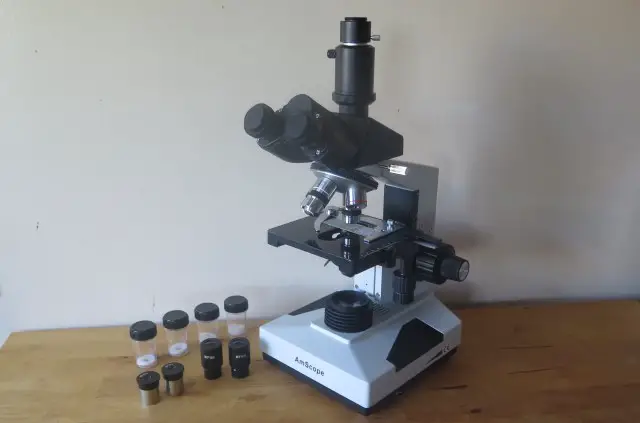
Beyond the third ocular tube for photography, the T490B is a really nice microscope. The objective lenses are really nice and even a step up from the B120C (reviewed later) in my opinion.
Another of my favorite features is the mechanical stage, which allows you to scan your specimen on the X-Y axis using a fine focus adjuster:
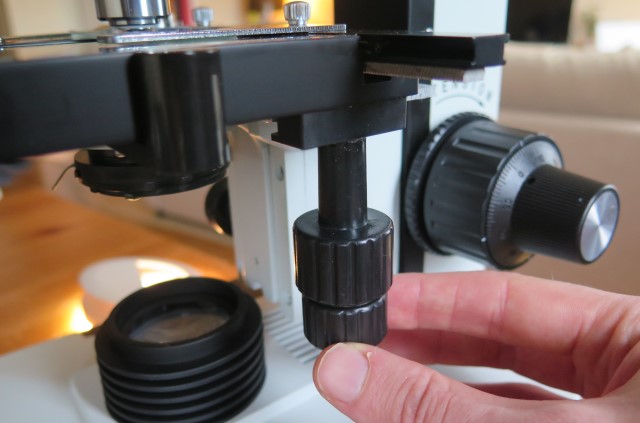
The binocular Siedentopf head is also really comfortable and easy to adjust, which is why I think most people would like this for their personal microscope at home, as opposed to a cheaper monocular microscope.
But perhaps more important for image quality is the 1.25 NA Abbe condenser with iris diaphragm, a huge step up from the entry-level lighting system of the Levenhuk Rainbow series (below).
AmScope offers additional condensers and objectives you can add onto this microscope if you want to start working with darkfield or phase contrast methods, making this a versatile microscope that you can upgrade in the future when your scientific curiosity demands it.
 Chris Says: “Overall, this is 100% the best compound microscope for hobbyists and even practitioners in my opinion. You can get it here.“
Chris Says: “Overall, this is 100% the best compound microscope for hobbyists and even practitioners in my opinion. You can get it here.“
I do admit that the T490B is usually a little more expensive than the B120C (reviewed later) and the B120C would probably make most intermediate level enthusiasts very happy. But I am willing to pay that little bit extra for the trinocular head on the T490B so I can take photographs of my specimens.
> Go to my full review of the Amscope T490B here
2. Levenhuk Rainbow 50L PLUS – Best Monocular
The Levenhuk Rainbow 50L is a beginners’ microscope made for budding microscopy enthusiasts. It’s best for people just starting out who want a play around but don’t need anything beyond the basics.
It offers:
- Monocular head
- Fixed stage
- Coarse focus knob
- Disc diaphragm
- Up to 1280x magnification
 Chris Says: “This microscope is simple, easy to use, and even comes with a bunch of prepared slides that I managed to get focus on within about 3 minutes of taking this microscope out of the box.”
Chris Says: “This microscope is simple, easy to use, and even comes with a bunch of prepared slides that I managed to get focus on within about 3 minutes of taking this microscope out of the box.”
There are several competitors on the market for entry-level microscopes, including several by AmScope, which all provide a basic microscope, case and a kit of experiments. Of the bunch, I think the Rainbow 50L PLUS beats them all out.
I struggled to find an entry-level microscope that wasn’t toy-level quality. Often the objectives on cheaper microscopes are just terrible above about 200X total magnification. The promises of a carry case and experiment kit are often used to wrap a gimmick with extra goodies for the purchaser.
I don’t think that’s the case with this model.
In fact, the discovery book (“Attractive Microscope. Scrutinizing the Microcosm”) is really impressive and I powered through the included experiments in a few days, having a lot of fun.
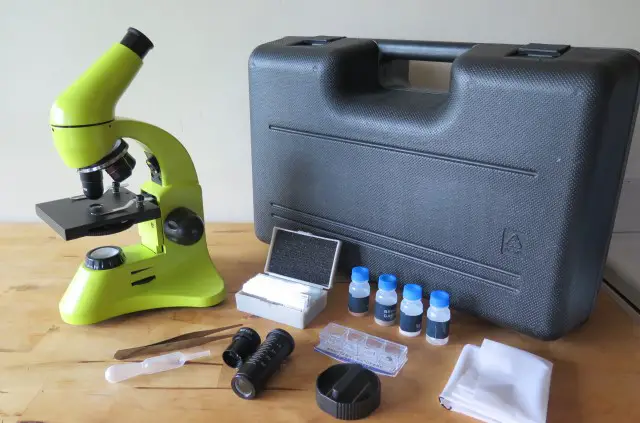
It’s designed to be very easy to use with just one simple 16X Barlow eyepiece and 3 decent quality objectives: 4х, 10х, and 40хs. I appreciate that the 40x objective is spring-loaded to protect it from damage (another indicator of the superior quality of this one over many other lower-priced microscopes).
There are a few reasons why you might not want this model though. It’s not got a mechanical stage and has only one focus knob (coarse focus). It’s also monocular, meaning you only look through with one eye (tip: kids tend to cope with monocular microscopes better than binocular models).
I understand that these design decisions were about making this a simple, easy-to-use microscope (and at lower magnifications you probably don’t need a mechanical stage anyway). But for teens and beyond, I think you’d probably want to step up to the higher-quality microscopes like the AmScope B120, which I’ll review next.
> Go to my full review of the Levenhuk Rainbow 50L Plus here
3. Amscope B120C – Affordable Option for Hobbyists
The Amscope B120C series is another real workhorse that does quite well at a good price point. If you’re adamant you don’t want to get into photography, it’s probably worth just getting the B120 instead of the T490 above as you wouldn’t need the trinocular head, but you still get the nicer features like the mechanical stage and Abbe condenser.
The B120 either comes at max. 1600X magnification (B120A), 2000X magnification (B120B) or 2500X magnification (B120C). Overall, I do think all you’d need is the 1600X magnification because at those higher magnification levels you don’t get much extra out of it.
The most impressive thing about the B120 series is that it’s not outrageously expensive and yet is in the higher category where you get the creature comforts of a Siedentopf binocular head, Abbe condenser and mechanical stage. You’ll also get a 100X objective that is oil immersion ready (it even comes with an oil sample to get started).
 Chris Says: “This is a microscope anyone can buy and that can get you through 95% of beginner, intermediate and advanced microscopy tasks you want to get done.”
Chris Says: “This is a microscope anyone can buy and that can get you through 95% of beginner, intermediate and advanced microscopy tasks you want to get done.”
Overall, this is a good workhorse for a personal at-home microscope. The one thing it’s missing is a camera. As noted above, if you’re interested in photographing your findings, it’s best to go with a trinocular model.
> Go to my full review of the Amscope B120C here
4. The Swift SW380B
The Swift SW380B is a wildly popular microscope. The specifications of this microscope are comparable to my AmScope B120, and to be honest the biggest reason I went with the AmScope over the Swift is that in my opinion AmScope has a better business-to-consumer presence (online support, etc.), which I thought might come in handy at some point.
But when you look at the specs, you can see this microscope has got all you need: a Sidentopf binocular head, DIN standard lenses (including oil immersion), mechanical stage, 1W LED sub-stage lighting, and an industry standard Abbe condenser.
The SW380 can also be purchased as a trinocular model.
 Chris Says: “Overall, there’s nothing wrong at all with this microscope, and it was just personal brand preference that I bought my AmScope T490 over this one.”
Chris Says: “Overall, there’s nothing wrong at all with this microscope, and it was just personal brand preference that I bought my AmScope T490 over this one.”
> Go to my full review of the Swift SW380B here
5. The Celestron CM2000CF
Celestron is a pretty well-established brand in the microscopy space, but their main bread and butter is telescopes. I looked through Celestron’s range for their top value compound microscope and I settled on the Celestron CM2000CF as their best value for money.
I had originally considered the CM800, but I would have wanted the mechanical stage which is only offered from the CM2000 and up.
So in general, this is the lowest I’d go in the Celestron range.
This is the last of Celestron’s monocular microscopes, but you can step up to the CB2000F which is essentially this microscope but with a binocular head.
In terms of specs, one thing I am impressed by is the NA 1.25 Abbe condenser with iris diaphragm – you don’t see this all that often with monocular compound microscope models.
 Chris Says: “Overall, this is a nice enough microscope, and it’s got impressive specs for an entry-level monocular compound microscope. I’d say it’s my top value pick in Celestron’s range.”
Chris Says: “Overall, this is a nice enough microscope, and it’s got impressive specs for an entry-level monocular compound microscope. I’d say it’s my top value pick in Celestron’s range.”
> Go to my full review of the Celestron CM2000CF here
6. OMAX 40X-2500X (MD82ES10)
The Omax 40X-2500X MD82ES10 is a really interesting proposition. It’s one of the few microscopes I’ve seen that has a camera built right into the head. So it’s effectively got the benefits of a trinocular microscope without the actual head.
It’s got many of the expected features like a 1W LED light, 1.25 BA Abbe condenser and iris diaphragm, 2000X magnification and mechanical stage.
One downside is that the internal USB Camera is only 1.3MP which won’t deliver 1080P quality images. The resolution will be FAR less than your average phone camera, so expect some blur when trying to display your images on the screen. (Personally my preference is to attach a DSLR camera using a camera to microscope adapter).
The other thing that turned me away is that Omax tends not to use Siedentopf head technology so I find their binocular eyepieces to be a little less user-friendly than comparable brands.
 Chris Says: “So overall, while this Omax is a decent microscope, the inability to upgrade to a better USB camera and lack of Siedentopf head meant I decided not to purchase this model.”
Chris Says: “So overall, while this Omax is a decent microscope, the inability to upgrade to a better USB camera and lack of Siedentopf head meant I decided not to purchase this model.”
> Go to my full review of the Omax MD82ES10 here
7. The Levenhuk 720B
The Levenhuk 720B is very comparable to my AmScope B120 and the Swift SW380.
The one thing that does really stand out against those competitors is the 3W LED sub-stage lighting. That’s solid!
Most other features are comparable – mechanical stage, 4x, 10x, 40xs, and 100xs objectives (the ‘s’ stands for spring-loaded to protect it against accidental knocks against your slides), Abbe condenser and iris diaphragm.
There are 10X and 20X eyepieces included to allow for up to 2000X magnification. One downside, which was the key reason I didn’t get this microscope is that the 20X eyepiece. It’s a Huygens lens eyepiece which doesn’t allow for measurement calibrations. Most people probably would never notice this, but because I like to calibrate eyepieces using an aftermarket size insert so I can measure the width of cells, I decided to go with the AmScope B120 instead.
> Go to my full review of the Levenhuk 720B here
8. AmScope M150C-MS
I’ve always wanted this microscope, but have never had a compelling reason I should get it. Perhaps if I were to start again, this would have been my first microscope.
It’s a basic entry-level monocular compound microscope (much like the Levenhuk Rainbow series), but has some additional features like a fine focus knob and mechanical stage.
If you’re willing to pay for these features, this is probably the best entry-level monocular microscope you can get. I don’t know of any direct competitors in the monocular microscope range with a good mechanical stage like this one. And I do love a mechanical stage – it makes user experience far, far better!
But remember to get the model with -MS on the end of it. There are a lot of M150C models out there, but only the -MS model has that mechanical stage that makes it stand out above many of the others in the entry-level category.
> Go to my full review of the Amscope M150C-MS here
9. Telmu 40X – 1000X
The Telmu 40X – 1000X is a hugely popular monocular microscope, but I think it’s more popular than it merits. It’s a basic compound microscope that wouldn’t cut it for a professional microscope, but would be an okay home microscope for a casual hobbyist.
Its magnification is up to 1000X, using 10X and 25X eyepieces and 4x, 10x, and 40x rotating objectives. That’s lower than most others on this list, but sufficient for most tasks.
I found it a bit odd that there was an above-stage light (most serious compound microscopes only have sub-stage lighting). Above-stage lights are only for visible matter, really, which is why we tend to only have them on stereo microscopes.
The light aperture disc isn’t all that great either – it’s a rotating disc with several pre-set apertures.
Overall, I’d be okay with this as a monocular microscope for beginners, but you’d grow out of it fast. This one is most comparable to the Levenhuk Rainbow 50L PLUS that I reviewed earlier in this piece.
> Go to my full review of the Telmu Microscope here
A Few FAQs
If you’re not sure about anything, I’d encourage you to browse around this website. I’ve tried to provide as much beginner-level information as possible. Below are a few answers to what I think would be the most common questions first-time buyers have.
Is a Compound Microscope Right for Me?
There are two types of microscope: compound and stereo.
Compound microscopes are for looking at specimens invisible to the naked eye. Examples include: saliva, bacteria in pond water, onion skin cells, fingerprints, and mold.
Stereo microscopes are for looking at visible specimens like rocks, leaves, coins and feathers. They’re fun, but they’re really just glorified magnifying glasses.
Having said that, there’s value in both types. I’d say if you’re a rock or coin collector or into jewelry repairs, a stereo microscope would be okay. Otherwise – go for a compound microscope. They’re the most popular and common variety.
Why isn’t there an Above Stage Light?
Above stage lights are used for illuminating visible samples like rocks and coins. Sub-stage lighting is used for viewing translucent specimens like bacteria and cells. Above stage lights are just about useless for compound microscopes because you’ll want to illuminate your translucent specimens from below.
Does Everything Come in the Package?
Usually, everything you need to operate a microscope is included in the purchase. That includes a power cord, stage, and lighting equipment.
Some beginner level home microscopes are also shipped with starter kits, which commonly include shrimp eggs, brine, dyes, and prepared slides. As a general rule, if the microscope is shipped with a starter kit, it’s usually not a great microscope (sounds harsh, but it’s kind of true).
Having said that, I did really like the starter kit and book provided with the Levenhuk Rainbow 50L PLUS, and I think the microscope is great for beginners, too. Here’s the kit you get with this microscope:
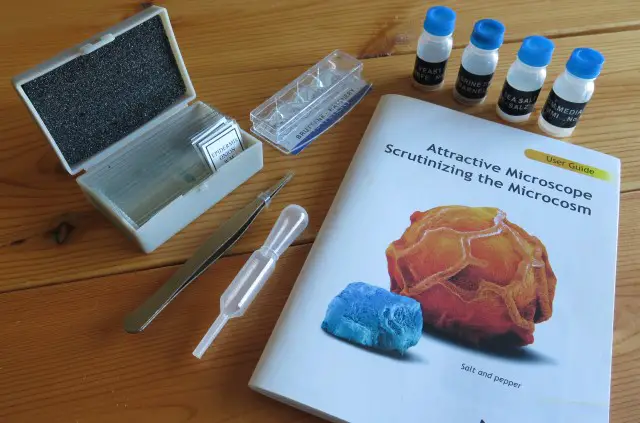
If you’re really keen on getting started with microscopy, I’d probably still recommend the AmScope B120 and suggest you get an experiment kit separately.
Final Thoughts
While I generally like to recommend just one product to help you cut the wheat from the chaff, the truth is you need to choose one that fits your needs.
Overall, I think most people would be most satisfied with the AmScope T490B [1] if you can afford it. It’s a really nice workhorse of a microscope. The step down to the Levenhuk Rainbow 50L PLUS does feel like a big step down, but it’s still a nice product for beginners.
I do hope this review has been useful to you and good luck with your microscopy!
Cheers,
Chris
Hi, I’m Chris and I run things around here! I share all my microscopy experiments, microscope information and tricks, how to guides, and microscope reviews in the articles on this site. Browse around to see what you like (I recommend the experiment ideas section) or connect with me on any of the social platforms listed below.
